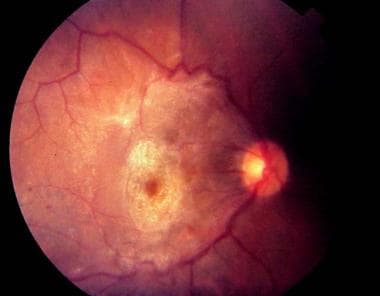Background
An epiretinal membrane (ERM) is a collection of collagenous cells that occurs on the inner surface of the central retina. These membranes have contractile properties and can lead to visual changes and metamorphopsia because of their effect on the underlying retina. See the image below.
Very dense epiretinal membrane with associated macular distortion.
This ocular pathology was first described by Iwanoff in 1865, and it has been shown to be a relatively common entity, occurring in about 7% of the population. Epiretinal membranes have been called various names, including epimacular membranes, cellophane maculopathy, preretinal macular gliosis, preretinal macular fibrosis, macular pucker, preretinal vitreous membranes, epiretinal astrocytic membranes, surface wrinkling maculopathy, internoretinal fibrosis, and silk-screen retinopathy; all of which pertain to clinico-anatomic descriptions of pathologic findings produced by epiretinal membranes of varying severity and differing morphologic characteristics.
Epiretinal membranes can be associated with various ocular conditions, such as posterior vitreous detachments (PVD), retinal tears, retinal detachments, retinal vascular occlusive diseases, ocular inflammatory diseases, and vitreous hemorrhage. However, a large proportion of cases do not occur in the context of any associated disease or known history and therefore are classified as idiopathic epimacular membranes (IEMM). Idiopathic and postdetachment membranes are the most common epiretinal membranes and, as such, are the focus of this article.

